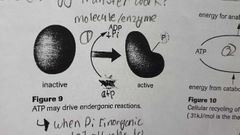![]()
![]()
![]()
Use LEFT and RIGHT arrow keys to navigate between flashcards;
Use UP and DOWN arrow keys to flip the card;
H to show hint;
A reads text to speech;
6 Cards in this Set
- Front
- Back
|
ATP |
one adenine group + ribose group + three phosphate groups |
|
|
ADP |
When the third phosphate group is removed through a hydrolysis reaction (it's least stable so easy to removed) you end up with an ADP enzyme |
|
|
Inorganic phosphate |
The phosphate that was released, the ∆G is negative and it had a lot of free energy |
|
|
How energy transfer works (picture) |

:) |
|
|
How energy transfer works (text) |
When PI (inorganic phosphate) attaches to an inactive monocle, that molecule changez shape and activates. The addition of PI is called phosphorylation this is how energy is transferred in a Cell |
|
|
coupled reaction |
at this point the remaining ADP has to be recharged with another Pi, which comes from the oxidation in the food we eat. That's what we call cellular respiration |

